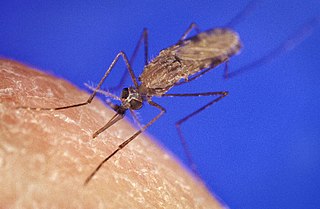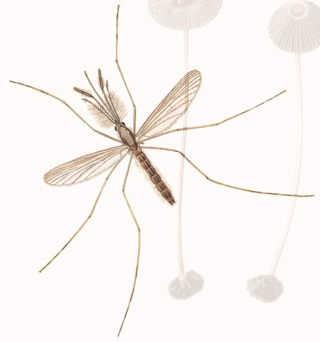
Anopheles is a genus of mosquito first described and named by J. W. Meigen in 1818. About 460 species are recognised; while over 100 can transmit human malaria, only 30–40 commonly transmit parasites of the genus Plasmodium, which cause malaria in humans in endemic areas. Anopheles gambiae is one of the best known, because of its predominant role in the transmission of the most dangerous malaria parasite species – Plasmodium falciparum.

Plasmodium ovale is a species of parasitic protozoon that causes tertian malaria in humans. It is one of several species of Plasmodium parasites that infect humans, including Plasmodium falciparum and Plasmodium vivax which are responsible for most cases of malaria in the world. P. ovale is rare compared to these two parasites, and substantially less dangerous than P. falciparum.

The Anopheles gambiae complex consists of at least seven morphologically indistinguishable species of mosquitoes in the genus Anopheles. The complex was recognised in the 1960s and includes the most important vectors of malaria in sub-Saharan Africa, particularly of the most dangerous malaria parasite, Plasmodium falciparum. It is one of the most efficient malaria vectors known. The An. gambiae mosquito additionally transmits Wuchereria bancrofti which causes lymphatic filariasis, a symptom of which is elephantiasis.

Anopheles culicifacies is a mosquito species complex and one of the major vectors of malaria on the Indian subcontinent. It consists of five sibling species, provisionally designated as species A, B, C, D, and E. It prefers to rest indoors in cattle sheds, where it feeds on cattle. The control of A. culicifacies has become difficult due to development of insecticide resistance against all commonly used insecticides, including new-generation insecticides such as synthetic pyrethroids.
Anopheles barberi is a tree hole breeding mosquito mainly located in eastern North America. The larvae are predators of other mosquito larvae. It has been shown to be a vector of malaria in the laboratory, but it is not thought to be an important malaria vector in the wild.
Anopheles crucians is a mosquito that exists in aquatic environments under areas with little light presence. The preferred environment for A. crucians is areas with acidic water such as that found in cypress swamps. The mosquito breeds in semipermanent and permanent pools, ponds, lakes and swamps.

Anopheles is a genus of mosquitoes (Culicidae). Of about 484 recognised species, over 100 can transmit human malaria, but only 30–40 commonly transmit parasites of the genus Plasmodium that cause malaria, which affects humans in endemic areas. Anopheles gambiae is one of the best known, because of its predominant role in the transmission of the deadly species Plasmodium falciparum.
Anopheles (Cellia) subpictus is a species complex of four species of mosquito belonging to the genus Anopheles.

Anopheles albimanus is a species of mosquito in the order Diptera. It is found in coastal Central and South America, the Caribbean, and Mexico. It is a generalist species and capable of wide dispersion. A. albimanus is a common malaria vector.

Anopheles claviger is a mosquito species found in Palearctic realm covering Europe, North Africa, northern Arabian Peninsula, and northern Asia. It is responsible for transmitting malaria in some of these regions. The mosquito is made up of a species complex consisting of An. claviger sensu stricto and An. petragnani Del Vecchio. An. petragnani is found only in western Mediterranean region, and is reported to bite only animals, hence, it is not involved in human malaria.
The Walter Reed Biosystematics Unit ("WRBU") is a US Army organization that conducts laboratory and field research on the systematics of medically important arthropods in support of epidemiological investigations and disease prevention and control strategies of importance to the military. Research is carried out worldwide, within geographic or faunistic restrictions of the material available and military requirements. Research efforts focus on the development of accurate and reliable means of identifying vectors of arbopathogens of humans.
The subgenus Kerteszia are Neotropical anopheline mosquitoes originally described in 1905 by Frederick V. Theobald as genus Kertészia with Kertészia boliviensis as the type species.
Plasmodium odocoilei is a species of parasites, that causes malaria in white-tailed deer.
Anopheles (Anopheles) nigerrimus is a species complex of zoophilic mosquito belonging to the genus Anopheles. It belongs to the Nigerrimus Subgroup and Hyrcanus Group of the Myzorhynchus Series. It is found in India, and Sri Lanka, Bangladesh, Brunei, Cambodia, China, Malaysia, Myanmar, Nepal, Pakistan, Thailand, and Vietnam. It is a Possible malaria and filariasis vector. It is found from ecosystems nearby water courses such as rice fields, canals, large open marshes, and also in partially sunny, shady deep pools with floating vegetation. In Sri Lanka, the adult and larval stages are known to show resistant to a range of organophosphate and carbamate insecticides. Cytologically, two karyotypic forms of A. nigerrimus are identified, as Form A and B.
Anopheles (Cellia) tessellatus is a species complex of zoophilic mosquito belonging to the genus Anopheles. It is found in India, and Sri Lanka, Bangladesh, Cambodia, China, Indonesia, Malaysia, Laos, Maldives, Myanmar, Nepal, Philippines, Taiwan, Thailand and Vietnam. It is first described from Sri Lanka. Larva are known to found from dirty stagnant water in sun or shady habitats. Adults are zoophilic. It is not regarded as a malaria vector, but is a secondary vector of Wuchereria bancrofti in Maldives.
Anopheles nuneztovari is a species of mosquito in the order Diptera native to South America. The species was named by its discoverer, Arnoldo Gabaldón, to honor the Venezuelan entomologist Manuel Núñez Tovar.
Anopheles bellator is a species of mosquito mainly located in southeast of State of São Paulo, Brazil, is a main vector of malaria.

Anopheles maculipennis is a species of mosquito that can be found mostly in Europe except New Zealand; it is a main vector of malaria.
Anopheles moucheti is a species of mosquito that highly anthropophilia and endophilia, is can be mainly located in Congo Basin forest, Africa. It was main vector of malaria.






